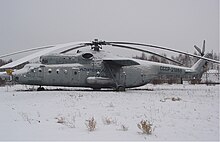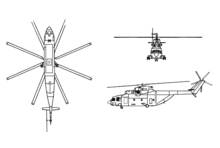Mil Wed-26
| Mil Wed-26 | |
|---|---|
 Freight version Mil Mi-26T |
|
| Type: | Heavy transport and multipurpose helicopter |
| Design country: | |
| Manufacturer: | |
| First flight: |
December 14, 1977 |
| Commissioning: |
1985 |
| Production time: |
in series production since 1981 |
| Number of pieces: |
316 (as of 2015) |
The Mil Mi-26 ( Russian Миль Ми-26 , NATO code name Halo ) is the heaviest, most powerful and largest helicopter in series production in the world. It was developed in the Soviet Union in the early 1970s to replace the similarly constructed Mi-6 , but it offers significantly more power.
description
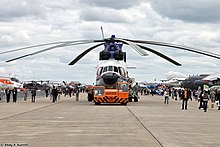
The Mi-26 is equipped with an eight-bladed rotor with a titanium rotor head. The five-person crew of pilot, copilot, navigator, engineer and a flight technician is housed in a pressurized cabin . Rotor blades, cockpit windows and the turbine inlets can be heated to enable use even at the lowest temperatures. The outer skin of the fuselage is made of aluminum .
In the military version, armor plates can also be attached to the underside, the aft bulkhead and the sides of the cockpit to protect the crew from anti-aircraft fire from the ground. Four of the eight fuel tanks and the turbines are also protected by light armor in this variant. The entire front part of the fuselage can be separated from the rest of the helicopter for maintenance and repair work by loosening the connecting bolts.
The cargo space is accessible via tailgates and a loading ramp. To support the loading, the helicopter has two electric LG-1500 winches that can pull loads of up to five tons into the hold.
The cargo hold of the Mi-26 is larger than that of the four-engine Antonov An-12 cargo aircraft and can accommodate 60 patients on stretchers plus nurses or two BMD airborne infantry fighting vehicles. In the TM version, the payload is 22,000 kg; alternatively, bulky loads with up to 20,000 kg can be carried on steel cables below the hull.
The passenger version offers seating for 82 passengers or can carry 68 fully equipped paratroopers .
In order to increase the tactical and flying value of the helicopter, it was equipped with an autopilot, an automatic hover stabilization system and the latest avionics for night flight.
The maiden flight took place on December 14, 1977. On February 3, 1982, the Mi-26 set a number of new records, including a flight with a total weight of 56,769 kg at an altitude of 2,000 m. From 1985 the helicopter was introduced with 60 copies in the then Soviet Air Force .
development
After the Mi-6 helicopter had proven inadequate for the new requirements of the Soviet military in the early 1970s, it was decided to develop a more powerful helicopter. In 1970 O. P. Bachow was appointed chief developer, who worked with his engineers from the Moscow helicopter factory until mid-1971 to develop the basics of the project, which was approved by the State Science Commission in December 1971. However, the entire list of military requirements for the Mi-26 could not be met, so that heavy armament, diesel fuel and self-propelled wheels had to be dispensed with in favor of a payload of 20 tons to be transported over 400 km at an altitude of 1500 meters.
In 1972 the external shape of the helicopter was determined. Two models on a 1: 1 scale were then produced by Mil / MWS , on which the details of the interior fittings were clarified. A Mi-6 was converted to test the new rotor and provided important results for its design.
In 1974 a model was agreed in cooperation with the suppliers and after numerous tests. The previous practice in helicopter developments in the Soviet Union had to be deviated from in order to design the complex transmission . The development office, which had previously planned all engine and transmission components for all helicopters since the Mi-1, could not take on this work, so the engineers at MWS developed the transmission themselves. The torque to be transmitted was 50% greater than that of the Mi-6.
In 1975 the rotor was completed, which instead of the five rotor blades of the Mi-6 had eight light, newly developed blades. It was possible to increase the thrust by 30% with a 40% reduction in the weight of the rotor . The tail rotor and some of the non-load-bearing parts were made from composite material to save further weight. The head of development of the project was replaced by W. Schutow and the main work was completed in the following months.
The first prototype of the Mi-26 was rolled out of the production hall near Lyubertsy on October 31, 1977 and made its three-minute maiden flight on December 14 . Two prototypes completed 150 flights with a total of 104 flight hours. The first series machine left the halls of the helicopter factory No. 168, today Rostwertol , in Rostov-on-Don on October 4, 1980 .
commitment
Military operations and accidents
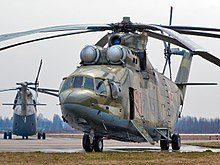
One of the first military missions included transport tasks for the Soviet troops in Afghanistan . During such a flight of a Mi-26 on October 18, 1985 from Moscow to Afghanistan, the tail rotor malfunctioned over Moscow. The pilot was still able to maneuver the machine out of the airspace of the densely populated area, but the machine was destroyed during the emergency landing. One crew member died and the pilot suffered fractures in both legs.
Mi-26 were used during the Nagorno-Karabakh War from 1992 to 1994 for the transport of relief supplies and the evacuation of refugees and troops. They carried out several dozen such missions, two helicopters were lost:
- On March 3, 1992, a Mi-26 was used to evacuate 50 Armenian refugees. A Mi-8 with Azerbaijani sovereign markings involved the protecting Mi-24 in a chase, while the Mi-26 was hit by a surface-to-air missile and crashed. Twelve people died.
- On May 12, 1992, a Mi-26 was supposed to be transporting food to a disputed region and was hit by an anti-aircraft missile. The machine crashed over Armenian territory and nine people died.
From 1994 to 1996 in the First and from 1999 to 2009 in the Second Chechnya War , Mi-26s were mainly used for military transport tasks.
In the first war, they usually only flew in twilight over areas held by opposing formations. Once launched, they rose to 100 to 200 meters in height to minimize the risk of being hit by infantry gunfire.
In the second Chechnya War, Mi-26s were responsible for the transport of supplies for troop units in mountain regions, whereby they only performed the first part of the transport, and Mi-8 helicopters were responsible for distributing the goods deposited at assembly points to the individual units.
In 2002, the Mi-26 missions were only flown under escort by Mi-24 attack helicopters or in poor visibility, as intelligence reports indicated the increased influx of shoulder-mounted anti-aircraft missiles among the rebel troops .
On August 19, 2002, a Mi-26 of the Russian Air Force , which had 150 soldiers on board, was nevertheless hit by such a missile while it was approaching the Khankala Air Force Base near Grozny . The engines caught fire and the machine had to make an emergency landing, but it got into a minefield at the airfield; 115 people were killed.
Civilian use
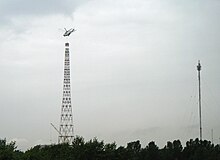
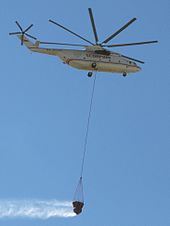
As part of their testing, Mi-26T performed the first transport tasks in the construction of power lines in Siberia from Tyumen at the beginning of 1986 .
In 1986 an Mi-26 transported the 18-tonne airframe of a Tu-142 from the Chkalovsky military airfield to Shcholkovo .
After the Chernobyl disaster in 1986, Mi-26s were used for numerous missions around the destroyed reactor. Some of the machines were used in the immediate vicinity of the open, radiant reactor and cleaned by hand by the ground staff without protective measures. The crews and pilots suffered radiation damage during these missions. While one of the machines showed only weak radiation after use with 1.5 times the normal value and remained in service, another machine, which showed 10 times the normal value, was buried after its last use.
In 1988 a Mi-26T transported a Mi- 8 helicopter that had crashed at an altitude of 3,100 meters in the Caucasus to Tbilisi airport .
Between 1989 and 1996, three Mi-26Ts were used in New Guinea to fly heavy drilling equipment, trucks and bulldozers into the rainforest so that a runway could be built there for heavy transport aircraft to build the infrastructure for an oil production project. An 8.6-tonne A-20G bomber that had crashed in New Guinea in 1945 was pulled out of a swamp by one of the Mi-26Ts and flown to a museum 150 kilometers away in October 1994.
A common use of the Mi-26T is to erect pillars and lattice masts for power lines. In 1997 a Mi-26T was used to erect 120 such masts in the Krasnodar region within four months .
On October 17, 1999, the approximately 23-tonne frozen sediment block containing the remains of the 20,000-year-old Jarkow mammoth was recovered with a Mi-26 .
In 2002 a rented Mi-26 was used to transport two US military emergency landed MH-47 helicopters out of the Afghan mountains. An MH-47 was transported 400 km. The operation lasted five hours and required two fuel stops.
In October 2005, Mi-26s were deployed to provide relief after the 2005 Kashmir earthquake . Within two months, one of the planes completed 207 flights and delivered 1,140 tons of cargo.
Mi-26s were used to fight fires in 2003 in France and in 2007 in Greece.
To repair the damage caused by the severe earthquake in China in 2008 , two Mi-26s were procured by the Chinese government.
In August 2009, the Alinghi 5 catamaran participating in the America's Cup was transported by a Mi-26T from Lake Geneva across the Alps to Genoa after it had been transferred to the lake in the same way in July 2009 from the assembly site in Villeneuve VD .
In October 2017, a Kazakh Mi-26 transported nine Asian wild asses in specially made transport boxes 1,200 kilometers from the Altyn Emel National Park to central Kazakhstan as part of a resettlement project by the Frankfurt Zoological Society , the Association for the Conservation of Biodiversity of Kazakhstan , Fauna & Flora International and other nine Asian wild asses .
Versions
- Mi-26 - ( Russian Ми-26) basic military version, of which the first serial production machine was completed on October 4, 1980. In 1986 the first machines were transferred to units of the Soviet Air Force.
- Mi-26A - (Russian Ми-26А) prototype from 1985 for testing a PK-90 type automatic navigation system.
- Mi-26T - (Russian Ми-26Т) civil transport helicopter, which went into series production in January 1985. Numerous adjustments, such as automatic securing devices for the cargo, a modified autopilot to compensate for the pendulum movements of attached cargo were installed, while the military components, such as the system for ejecting decoys, were no longer required.
- Mi-26TP - (Russian Ми-26ТП) fire-fighting helicopter from 1994, with four internal tanks for up to 15,000 liters of fire extinguishing agent, which can be drained in 45 seconds. Refilling the tanks on the ground takes a maximum of 2 minutes.
- Mi-26TS (certified) - (Russian Ми-26ТС сертифицированный) 1995 variant of the Mi-26T approved on the basis of the NLGV-2 approval rules of the CIS .
- Mi-26TM - (Russian Ми-26ТМ) flying crane from Rostwertol from 1993, with fly-by-wire control system and an observation dome in the fuselage for the pilot.
- Mi-26PK - (Russian Ми-26ПК) flying crane from the company MWS (Moskowski Wertoleti Sawod - Moscow Helicopter Factory) from 1997, with a control station for the crane operator on the port side of the fuselage.
- Mi-26TS - (Russian Ми-26ТС) flying hospital with a laboratory room, operating room for one patient, preparation room for two patients, an intensive care unit for four others, an additional area for up to five patients on stretchers and seating for three slightly injured people . (In the version as a pure transporter, up to 60 patients can be transported on stretchers with nursing staff.)
- Mi-26L 235 - (Russian Ми-26Л 235) geological research helicopter for prospecting tasks from 1987.
- Mi-26S - (Russian Ми-26С) disaster control helicopter to combat the consequences of the Chernobyl disaster of 1986. The only machine of this version was modified within just three days so that it could spray decontamination agents over the area .
- Mi-26TZ - (Russian Ми-26ТЗ) refueling helicopter for air and ground refueling with four hoses for air and up to 20 for ground refueling operations. 14,000 liters of fuel in tanks and up to 1,040 liters of liquids in canisters. A maximum of four machines were built from 1996.
- Mi-26PP - (Russian Ми-26ПП) prototype as a test carrier for electronic countermeasures (ECM) from 1986.
- Mi-26NEF-M - (Russian Ми-26НЕФ-М) prototype of a helicopter for submarine hunting from 1990, with diving sonar and a detector for magnetic anomalies (MAD), which could be lowered from the landing ramp and then towed.
- Mi-27 - (Russian Ми-27) Version from 1988 designed as a flying command post. Two machines of the type were built and housed six workplaces for communications personnel, a technical room and a multi-purpose area.
- Mi-26P - (Russian Ми-26П) prototype of a helicopter from 1992 for the border troops with special communication equipment.
- Mi-26M - (Russian Ми-26М) version from 1992, which is equipped with modified rotor blades and a new D-127 gas turbine for better flight performance.
- Mi-26T2 - (Russian Ми-26Т2) modernization package for older Mi-26 versions with strong automation to reduce the crew to just the two pilots. Digital cockpit, weather radar, GPS system and other adaptations are offered by the companies MWS and Rostwertol.
Users
Military users

- 14 × Mi-26 active (delivery since 2015)
- 3 × Mi-26 active (8 machines stored)
-
 Jordan : Jordanian Air Force
Jordan : Jordanian Air Force
- 4 × Mi-26T2 (the first of the 4 machines was delivered in January 2018)
- 0 × Mi-26 active (2 machines stored)
- 4 × Mi-26 active (15 machines stored)
-
 Democratic Republic of the Congo : Congolese Air Force
Democratic Republic of the Congo : Congolese Air Force
- 1 × Mi-26
-
 Laos : Laotian Air Force (Laos People's Liberation Army Air Force)
Laos : Laotian Air Force (Laos People's Liberation Army Air Force)
- 1 × Mi-26
- 1 × Mi-26
- 1 × Mi-26 (2 machines stored)
- 30 × Wed-26
- 4 × Mi-26 (supplied by Russia in 1996)
- 10 × Mi-26 (8 machines stored)
- 1 × Mi-26
-
 Venezuela : Venezuelan Air Force
Venezuela : Venezuelan Air Force
- 3 × Mi-26
- 10 × Mi-26 (5 machines stored)
Civil users
-
 People's Republic of China China Flying Dragon Aviation
People's Republic of China China Flying Dragon Aviation
- 2 × Mi-26T
- 4 × Mi-26TM ordered in 1997
- Aeroflot
- Avialift Vladivostok
- Scorpion (in Greece their Mi-26 is used, among other things, as a fire-fighting helicopter )
- UTair Aviation
- Russian civil protection . The company Heliswiss International rents a Mi-26T of the Russian civil protection if necessary.

-
 UN : The United Nations are using leased Mi-26s
UN : The United Nations are using leased Mi-26s
Technical specifications
| Parameter | Data |
|---|---|
| crew | 4-5 |
| Passengers | 82 |
| Total length with rotating rotors | 40.025 m |
| Length of fuselage without tail rotor | 33.73 m |
| Rotor diameter | 32.00 m |
| Rotor area | 804.25 m² |
| Height to rotor head | 8.15 m |
| Height, total | 11.60 m |
| Cargo hold size | 12.10 m × 3.29 m × 3.17 m (136 m³) |
| drive | 2 ZMKB Progress Lotarjow D-136 with 7,460 kW each (= 10,108 WPS ) later 2 PD-12W , throttled to 11,500 SHP |
| Marching speed | 265 km / h (143 kt ) |
| Top speed | 295 km / h (160 kt) |
| Operational range | 800 km |
| Empty mass | 28,600 kg |
| Preparation mass | 49,500 kg |
| Max. Takeoff mass | 56,000 kg |
| Max. payload | 20,000 kg |
| Fuel supply | 12,000 l |
| Summit height | 5,000 m |
Self-defense systems
The Russian Mi-26s have been modernized with the fully integrated and automatic self-defense system "Vitebsk" L-370W26L from NII Ekran FGUP due to the experience in the conflict with Georgia since 2011 . This consists of the following components:
- Active measures
- 2 × L-370-5 "President-S" - optoelectronic infrared guided missile jamming device ( DIRCM )
- 28 × OAK -UW-26C decoys with 32 × 26.6 mm heat flare decoys (OMI-PPI-26 or Adros PIK-26). For each half of the fuselage, 14 launchers are mounted above the main landing gear in an aerodynamic fairing.
- 2 × Artem ASO-2I decoys (32 × 50 mm IR decoys) in the older military versions.
- Passive action
The sensors are located in two aerodynamic containers on both sides in front of the main landing gear
- 2 × Asowsky / NTC Reagent L-136 "Mak-UFM" - Missile approach warning sensor (MAWS) searching for infrared emissions
- 2 × SOMS L-140 "Otklik" laser warning sensor
- 2 × CKBA Awtomatika SPO-32 / L-150-28- "Pastel" - radar warning sensor
Media reception
For the action film Die Hard - A Good Day to Die , the Belarusian civil protection service (MTschS Belarus) provided one of its Mi-26T (EW-260TF) for some scenes.
See also
literature
- Yevgeny Bobkow (Евгений Бобков): Тяжёлый вертолёт Ми-26 ( Eng .: Heavy Helicopter Mi-26), from the series Легенды авиации (Legends of Aviation) Issue 3, Novosibirsk 2008.
- Jefim Gordon : Mil's Heavy Lift Helicopters - MI-6, MI-10, V-12, MI-26. Midland Publishing, 2005, ISBN 1-85780-206-3 .
Web links
- Rostvertol website for the Mi-26T (English)
- Development and operational history of the Mi-26 on airwar.ru (Russian)
Remarks
- ↑ Complies with the US FAR-29 directive
Individual evidence
- ↑ Russia launches production of upgraded Mi-26, world's largest helicopter . Retrieved February 9, 2019.
- ↑ Russia to mourn helicopter dead. news.bbc.co.uk, August 21, 2002, accessed September 24, 2019 .
- ↑ Development and operational history of the Mi-26 on airwar.ru, accessed on May 26, 2017 (Russian)
- ↑ Justin Taylan: Papua New Guinea's Aviation icon: WWII Bomber B-17 "Swamp Ghost" , Report on theswampghost.com, 2003, page 17, accessed May 26, 2017
- ↑ Jarkow-Mammut on hanskrause.de, accessed on May 26, 2017
- ↑ Agency report on armstass.su, accessed on May 26, 2017 (Russian)
- ↑ Transport of Catamaran Alinghi 5 à through the Alps ( Memento from July 15, 2013 in the Internet Archive ) on helicomontagne.fr, accessed on May 26, 2017 (English)
- ↑ Wild donkeys fly into the steppe. fzs.org, accessed October 5, 2018 .
- ^ The Military Balance 2016. p. 361, International Institute for Strategic Studies (IISS), ISBN 1-85743-835-3 .
- ↑ Jordan receives first Mi-26T2. www.janes.com, accessed January 25, 2018 (English).
- ^ Air Forces Monthly, Key Publishing, September 2010, p. 68.
- ↑ Heliswiss International website about their Mi-26T ( Memento from December 24, 2013 in the Internet Archive )
- ↑ Vladimir Karnosow: New Engines For Russia's Heavy-lift Helicopter. In: ainonline.com. June 2, 2016, accessed May 31, 2017 .
- ↑ Observationsplatsen Category Archive helikopter on oplatsen.wordpress.com, accessed on May 26, 2017
- ↑ ( page no longer available , search in web archives )
- ↑ Katja Lüthge: To arms, men! . In: Frankfurter Rundschau , February 14, 2013, accessed on May 26, 2017

